Early Verdict
The Scythe Grand Kama Cross 3 offers very good cooling for system builders looking for performance on a budget. A great CPU cooler for situations where stretching those extra dollars can allow for upgrades of other performance components.
Pros
- +
Good value
- +
Large size allows slower, quieter fan
- +
Unique cooler design
Cons
- -
Somewhat awkward installation
- -
‘Distressed’ heat pipes around bends
- -
Less effective cooling motherboard components
Why you can trust Tom's Hardware
Features & Specifications
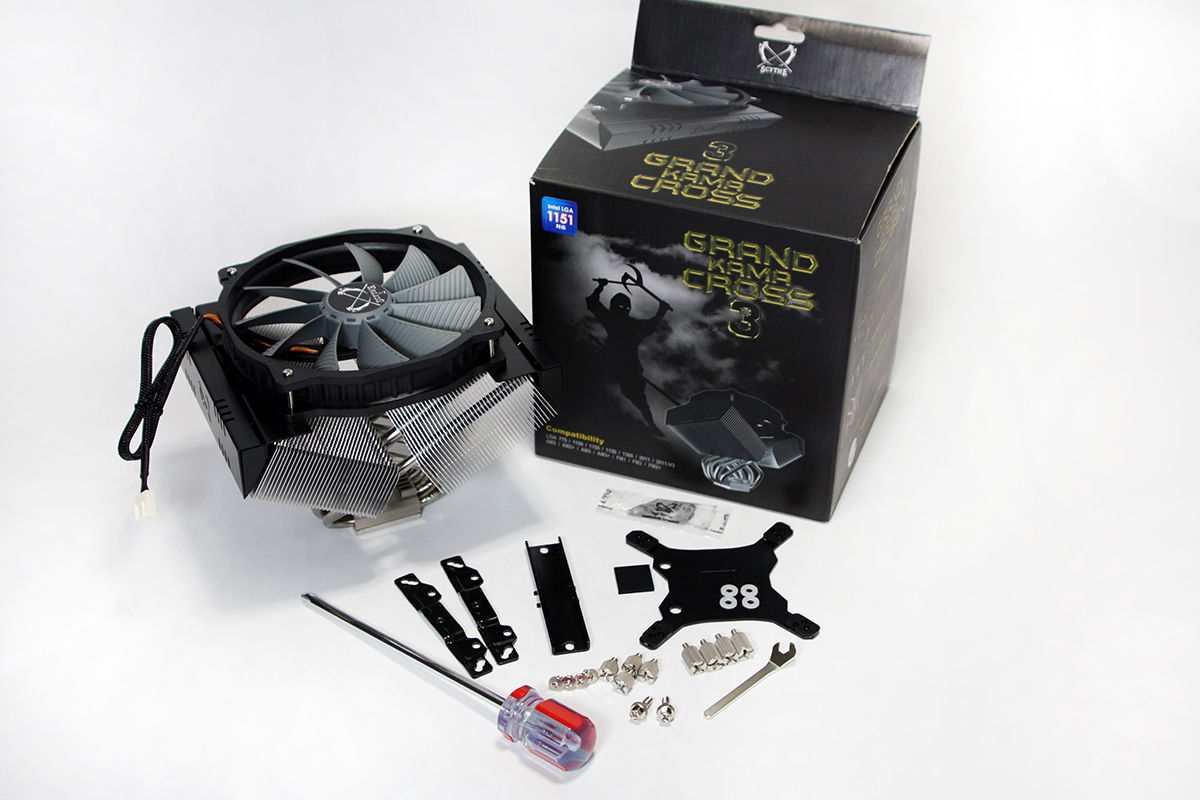
Mention the words "CPU cooler," and many readers will conjure an image of some form of copper or aluminum heatsink base, slotted fins, and a fan atop the unit. Before the dawn of all-in-one (AIO) closed-loop liquid cooling, the standard choice for processor cooling was the traditional air cooler. Now, CPU coolers compete against a legion of available cooling options for performance, visual flair, and the almighty dollar while appealing to every facet of customization or niche market.
Specifications
The Scythe Grand Kama Cross 3 is a large, 4-heatpipe cooler incorporating an 11-blade, 140mm fan above what could best be described as a ‘butterfly’ layout of fin arrays, rather than the traditional vertical tower layout. The cooler base is a solid piece of 1/8" (3.5mm) thick nickel-plated polished material (presumably copper), upon which the four heat pipes sit. This means Scythe has designed the Grand Kama Cross 3 not as a direct heat pipe cooler, as we've seen with many other solutions. Rather, it relies upon thermal conduction to move heat off the CPU's integrated heat spreader surface through a solid slab of metal and then into the heat pipes.
The base is highly polished and arrives devoid of any factory-applied thermal compound, although Scythe does include a small packet of paste.
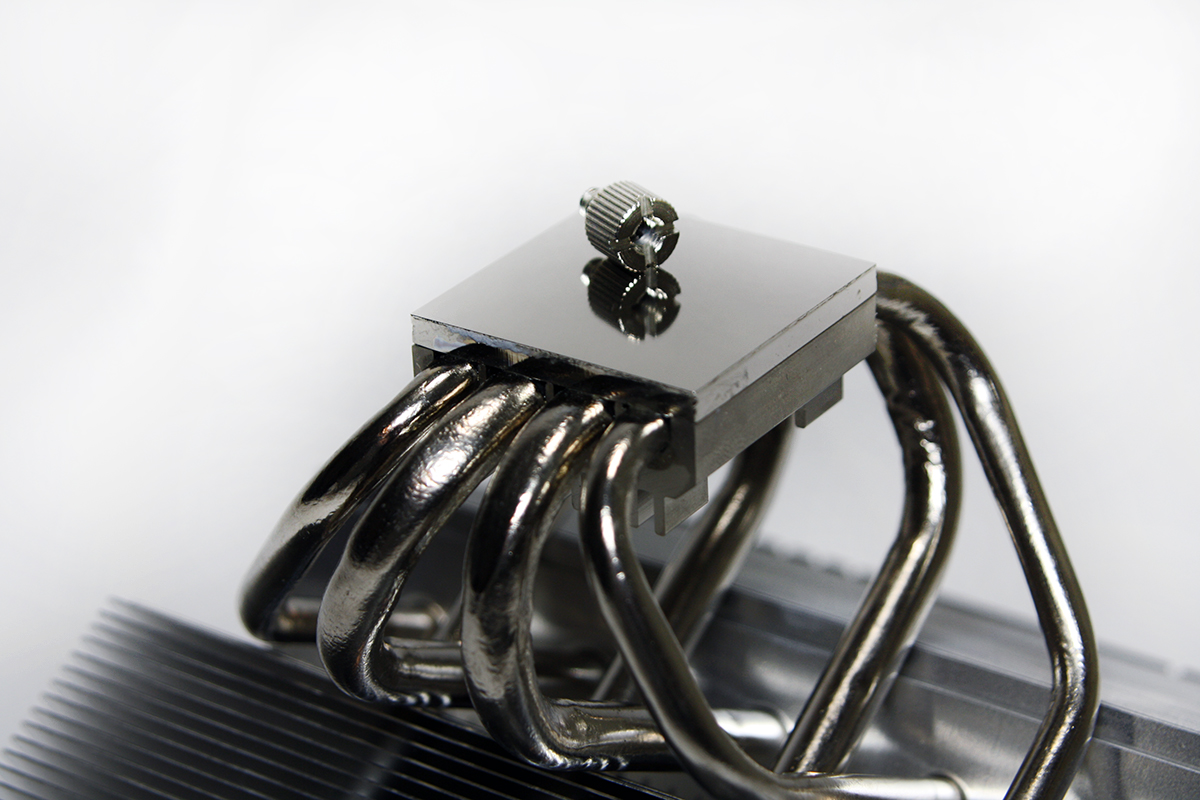
The collection of four heat pipes runs across the breadth of the base, but they don't have full contact with the mirror-finished base; you can easily see gaps around the heat pipes, because they aren't fully integrated into the base of the cooler or otherwise filled with solder. The heat pipes arc upward and then inward at close to a 45 degree angle, therefore crossing the opposing arms of each pipe before entering into the fin banks on either side, beneath the cooling fan.
The top of the fins and heat pipes terminate under the semi-gloss black-metal fan mount that also acts, somewhat, as a shroud. Airflow for the cooler is focused down and through the fins. One particularly curious thing is how the heat pipes are wrinkled and distressed, presumably from the process and stresses of bending them into the crossing shape for the cooler. Whether or not these imperfections impact cooling is unknown.
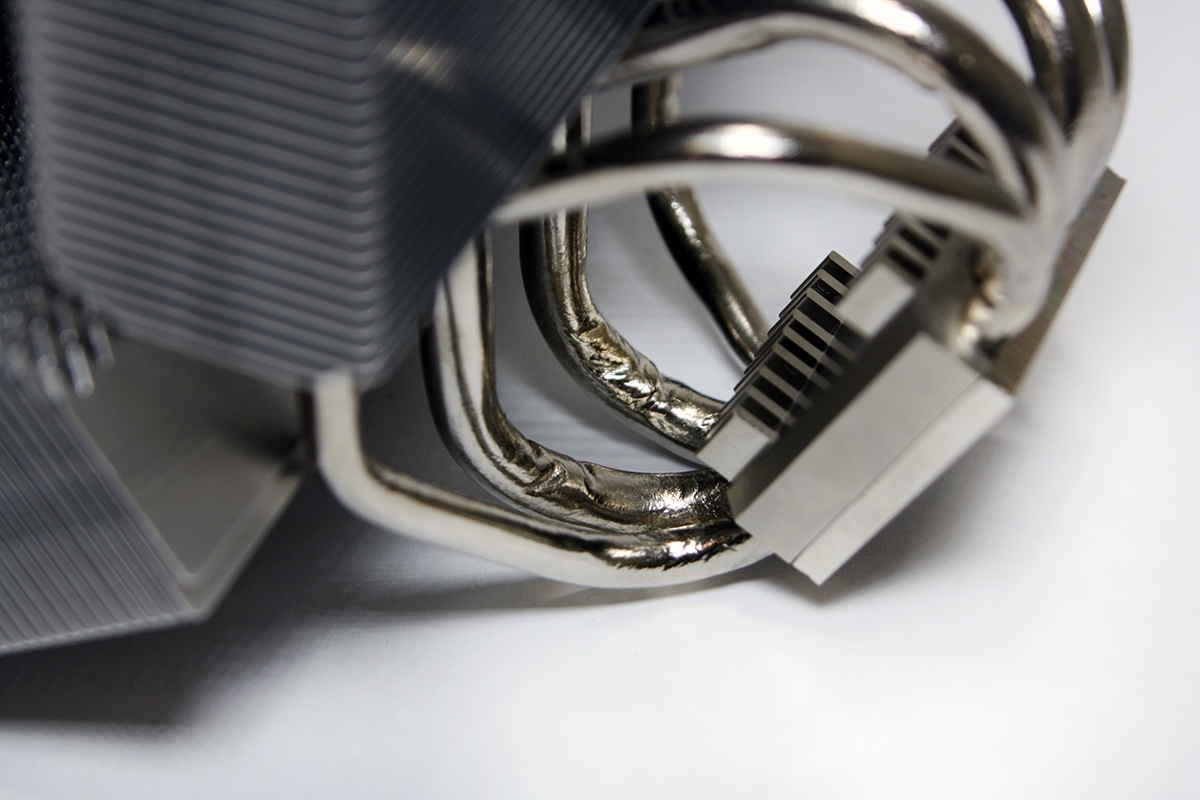
Although the shape and size of the cooler is unique and quite large, it does sit centered directly above the CPU socket without any noticeable offset. While installation for most air coolers is somewhat similar from cooler to cooler on any given Intel or AMD socket, the Scythe Grand Kama Cross 3 does require a bit of a balancing act and a special, long screwdriver (included) to affix the final cooler screws securely. The best method of reaching these screws is going directly down and through the fan and the cooler itself, but since the screwdriver is slightly magnetized, it allows for the screw to be placed on the Phillips’ end and guided into place from above, provided your aim is true.
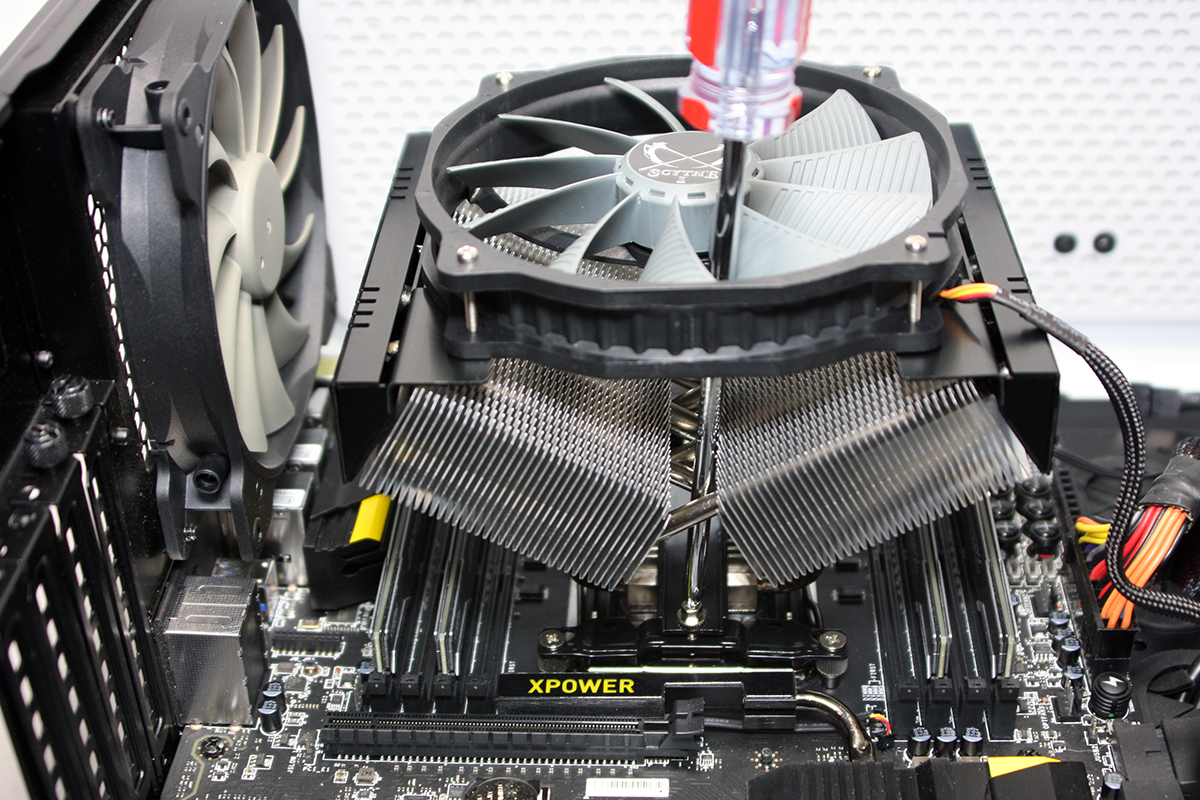
This final mechanical step does take a bit of finesse and almost requires an extra set of hands in order to steady the cooler and align these screws until both sides have their threads started in the mount. It took us a couple of attempts to get this just right and successfully mount the cooler. Once completed, the Scythe Grand Kama Cross 3 covers a great deal of real estate over the processor, system memory, and motherboard power delivery.
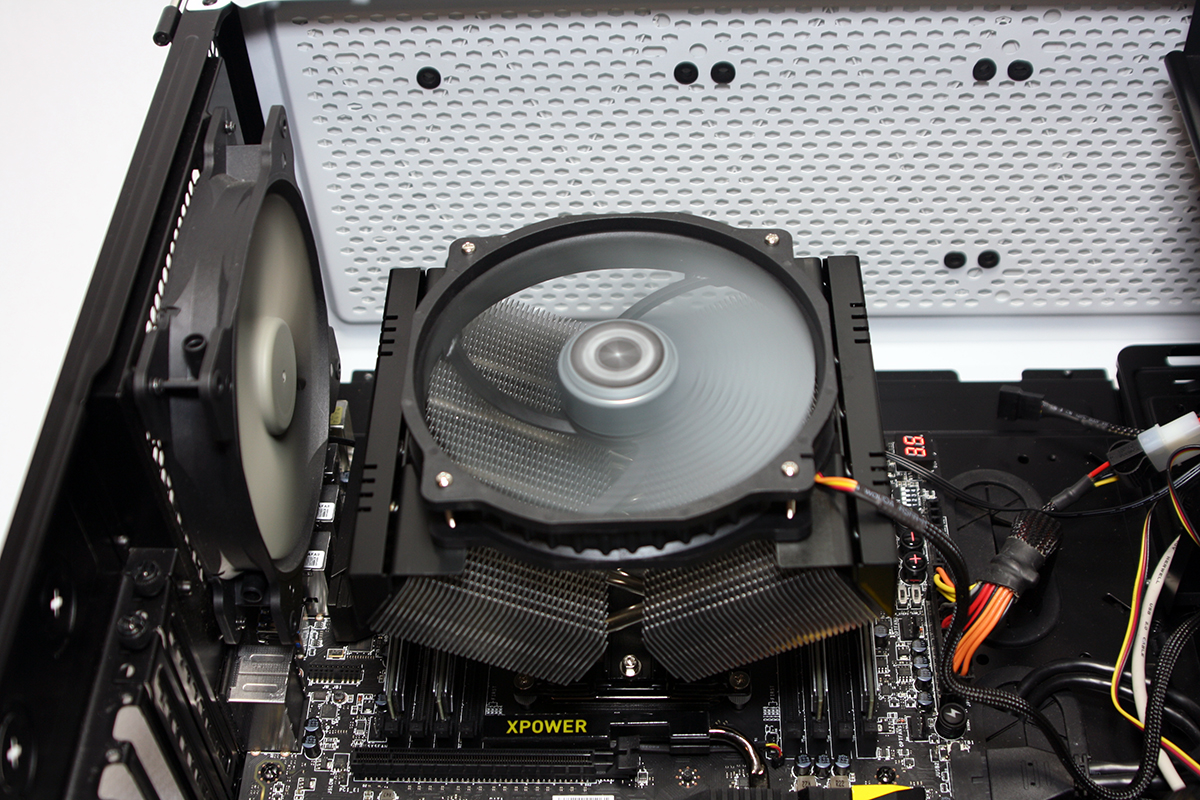
The cooler’s fin banks come close to the top-most PCI-e slot, but do not inhibit its use, provided a graphics card or other component does not have a large back plate or any raised connectors.
MORE: Best CPU Cooling
MORE: How To Choose A CPU Cooler
MORE: All Cooling Content
- 1
- 2
Current page: Features & Specifications
Next Page Comparison Coolers, Testing Results & Conclusion
Garrett Carver is a contributor for Tom’s Hardware, primarily covering thermal compound comparisons and CPU cooling reviews; both air and liquid, including multiple variations of each.
-
shrapnel_indie how much better would this do IF the sides were more closed off in terms of cooling? It seems to me that it may lose a portion to the sides when faced with the opportunity to take the path of least resistance.Reply -
eklipz330 how come no comparison to hyper 212 evo?Reply
i can imagine alot of the air flow speed is diminished before it reaches the fins. -
shrapnel_indie Reply20637829 said:how come no comparison to hyper 212 evo?
i can imagine alot of the air flow speed is diminished before it reaches the fins.
The EVO isn't very modern. It is beaten in it class of coolers by the likes of the Cryorig H7, and even the DeepCool Gammaxx 400 is better. None of these are in the same class. The Grand Kama Cross 3 is considered a big cooler, not a mid-size. -
The Original Ralph interesting results for only 4 heatpipes, and i like the configuration. A quieter fan and six heatpipes, i'd be on boardReply -
2Be_or_Not2Be Exactly how tall is this cooler? Pump height doesn't tell me.Reply
Edit: Newegg tells me the cooler height is 147mm. Why this review didn't include the very important detail in the specs, I have no clue. -
compprob237 I'm actually more curious about its effect on the VRMs and chokes of that X299 board you used. I bet that Scythe cooler is keeping them much cooler than the other two.Reply -
Kahless01 the distressed bends shouldnt do much if anything to cooling performance. watch motor trend test headers and bend and crimp the shit out of them and lose no real power.Reply -
The Original Ralph GOT A couple of ideas that would improve performance and probably beat out the Noctua NH-D15Reply
1st - the fins should have some baffles or louvers, like the red lines, to help the air flow establish a flow path that is parallel to the fins - entering the fins the way it is, the air flow is going to experience some turbelence and not scrub heat off the fins as well s it could. Look at the water cooled racing bikes like the Hondas - they have louvers or slats in front of the radiators similiar to the red lines i've drawn, as the radiators are mounted to the front rake tube on the frame and not perpendicular to the air flow. Those slats do exactly what i'm describing above, helping the air flow to establish a flow path parallel to the fins.
I only drew slats or louvers on one side, picture the fins will slats on both fin banks
2nd, the ends should be shrouded so that "V" valley is closed off, shrouded from the fan down to the bottom edge of the fins and shrouded on both ends.
3rd, and this is the mod that i think would give the biggest bang in terms of efficiency but would require modifying your case. This mod also assumes the mobo is mounted vertically. As the height is 147mm to the top of the fan, that's going to put it within 13mm (1/2") of my case's side panel, which means the fan is going to be struggling to pull air in to feed the fins.
But being so close to the computer case's side panel, it'd sure be easy to cut an opening to let that fan draw in fresh room air - that would probably give the biggest boost in performance.
anyway, fwiw -
Mr5oh Reply20637887 said:The EVO isn't very modern. It is beaten in it class of coolers by the likes of the Cryorig H7, and even the DeepCool Gammaxx 400 is better.
While that maybe true, the EVO 212 is still the old stand by and easily obtained at many local stores for many. The same is not true for the H7 unfortunately. So until that changes, it still makes the EVO 212 a good stanrdard. -
knowom I'd try reversing the fan direction on the top cooler to pull air upward and adding two fans underneath that push air through each heatsink stack array and see how it's performance...I'm sure you've got two fans you could zip tie on easily enough.Reply